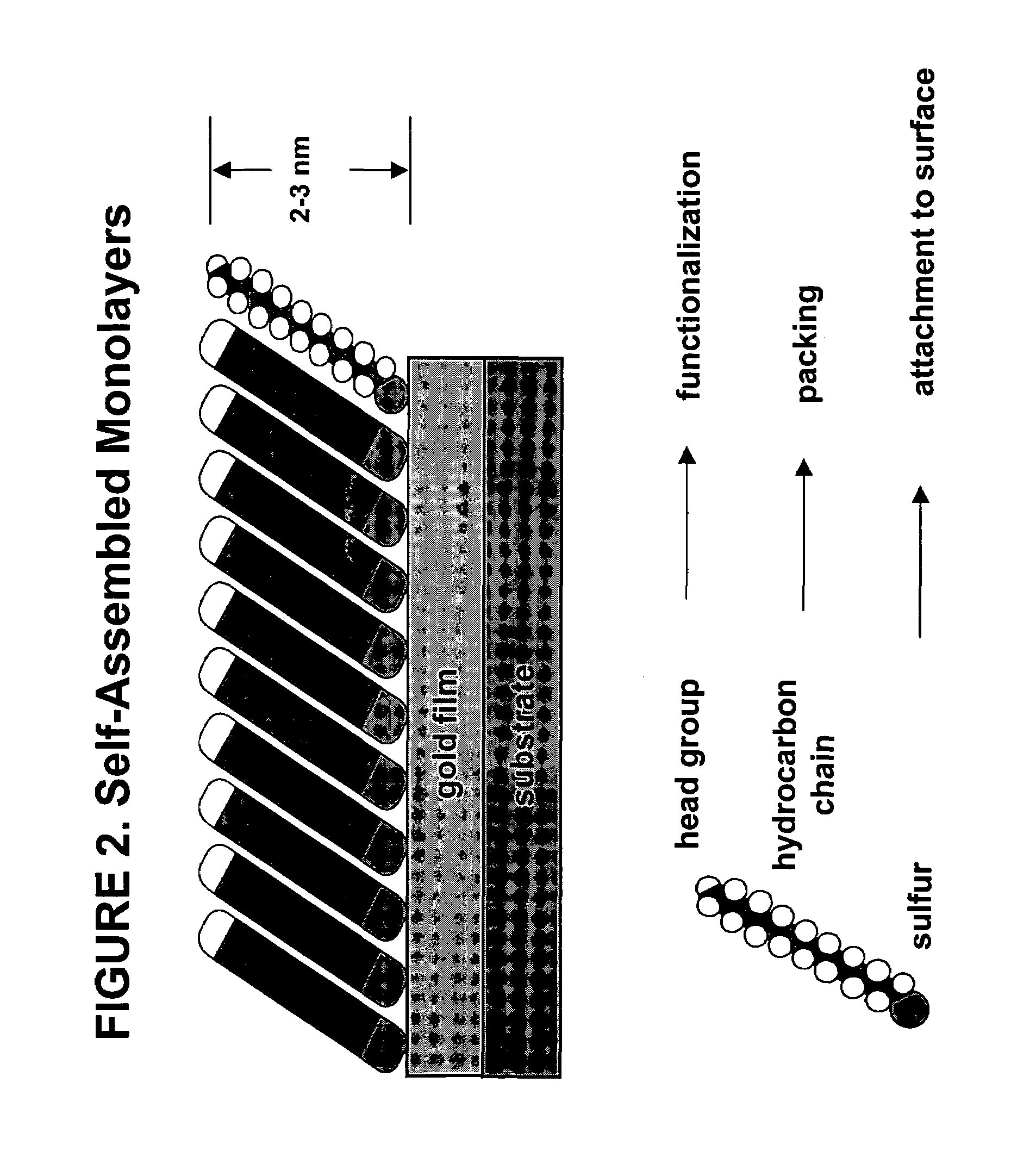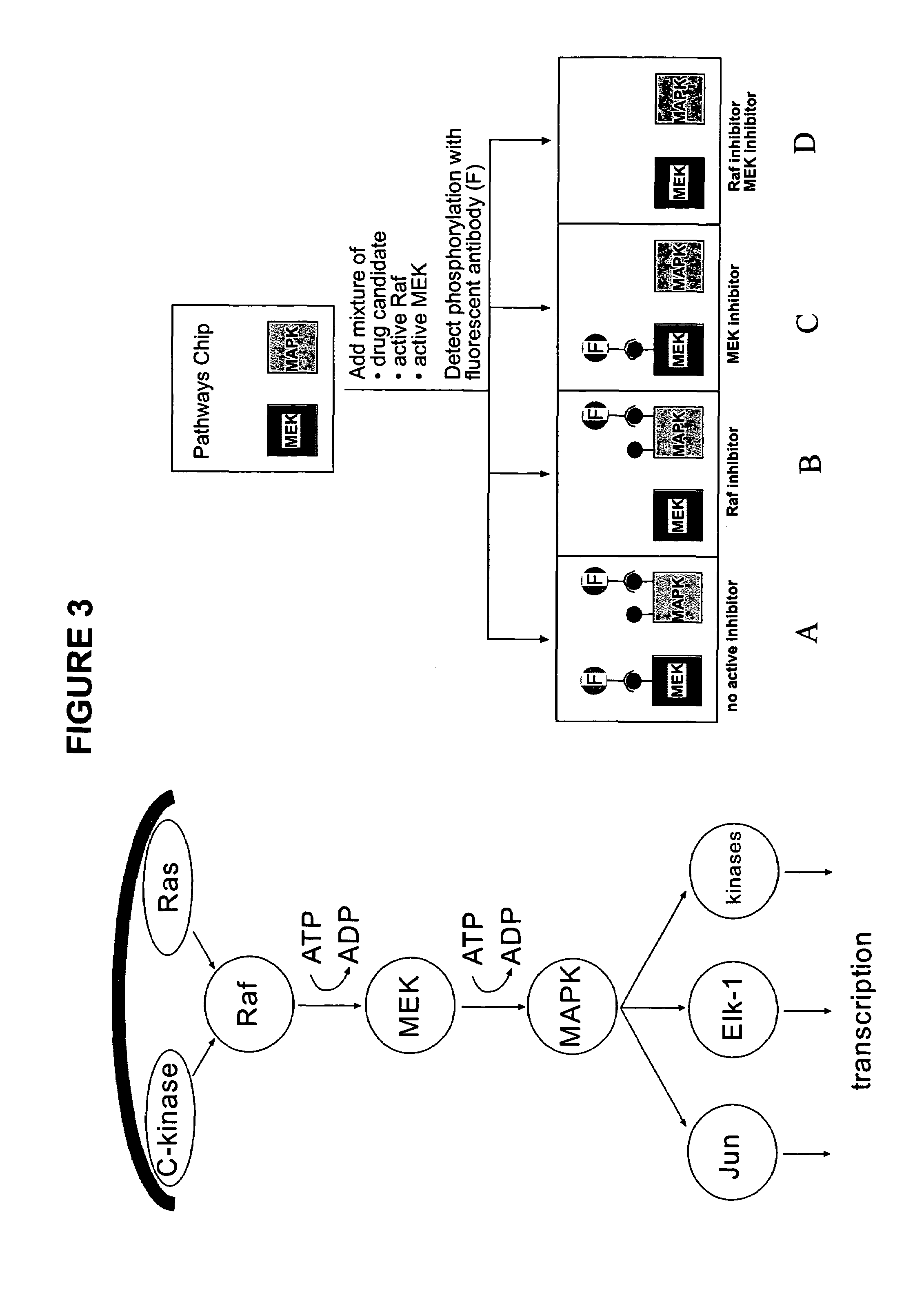Biomolecule arrays
a biomolecule and array technology, applied in chemical/physical processes, enzymology, on/in inorganic carriers, etc., can solve the problems of not providing molecular level information on how proteins interact to control cell behavior and physiology, genomics does not provide direct information on the interactions between proteins, and the level of transcribed mrna is not reliable to assess the amount or nature of proteins, etc., to facilitate the simultaneous monitoring of many interactions and high throughput
- Summary
- Abstract
- Description
- Claims
- Application Information
AI Technical Summary
Benefits of technology
Problems solved by technology
Method used
Image
Examples
example 1
[0132]An array of biotinylated-peptide tyrosine kinase substrate was immobilized on a surface that had been micro-contact printed with COOH-terminated thiol (in a background of EG3-terminated thiol) using EDC / NHS coupling, biotin-amine, and streptavidin. See, FIG. 4. A solution containing p60c-src (a member of the src family of kinases) and ATP was then placed on the array to enzymatically add a phosphate group to the tyrosine residue of the substrate. A primary antibody that specifically binds to tyrosine phosphate groups was then incubated on the array. A fluorescein-labeled secondary antibody that recognizes the primary antibody was then incubated on the array. The fluorescence from the bound secondary antibody was then detected using a fluorescence microscope with a fluorescein cube (excitation 480 nm; emission 530 nm).
[0133]The experiment and three control experiments (without enzyme; without substrate; with CH3-terminated microcontact printed SAM) showed that the enzymatic add...
example 2
[0134]A number of peptides (ranging from 10 to 1000s) that are designed to be substrates for kinases are arrayed onto a surface having islands of binding SAM using a suitable robotic liquid delivery method. Several arrays of the set of peptides are created to yield an “array-of-arrays”. After immobilization of the peptides to the surfaces, the surface is washed. Solutions containing a kinase, or a lysate of a cell expressing a certain set of kinases, ATP, salts, and buffer are then placed in contact with the pre-formed peptide arrays. If multiple different solutions or lysates are tested, then each solution is delivered to individual arrays within the “array-of-arrays”.
[0135]The phosphorylation of the immobilized peptides by the kinase(s) is allowed to proceed (typically at 37° C. for 30 min). The substrate is then washed in a 8 mM solution of sodium dodecyl sulfate (SDS) and tris-buffered saline buffer containing 0.01% Tween-20 surfactant. The degree of phosphorylation of the pepti...
example 3
[0137]An array according to the present invention will be used to monitor the Raf / MEK / MAPK pathway. This serine / threonine phosphorylation cascade activates MAP-kinase (MAPK) that initiates proliferation and differentiation. The pathway is schematically illustrated in FIG. 3. Inhibitors of this pathway are being developed as anti-tumor and anti-inflammatory agents. In this array, two proteins involved in the pathway are immobilized on the surface: inactive MEK and inactive MAPK. The solution above the protein array contains the active Raf and MEK enzymes, as well as potential inhibitors of this pathway and ATP. The array is exposed to potential inhibitors of Raf and / or MEK in solution. After incubation of the assay solution above the array, antibodies that are specific to phosphorylated residues of MEK and MAPk are incubated on the array. If the inhibitor prevents the phosphorylation of the immobilized enzymes by RAF or MEK then the antibody will not bind and, therefore, will not be ...
PUM
| Property | Measurement | Unit |
|---|---|---|
| areas | aaaaa | aaaaa |
| thick | aaaaa | aaaaa |
| thickness | aaaaa | aaaaa |
Abstract
Description
Claims
Application Information
 Login to View More
Login to View More - R&D
- Intellectual Property
- Life Sciences
- Materials
- Tech Scout
- Unparalleled Data Quality
- Higher Quality Content
- 60% Fewer Hallucinations
Browse by: Latest US Patents, China's latest patents, Technical Efficacy Thesaurus, Application Domain, Technology Topic, Popular Technical Reports.
© 2025 PatSnap. All rights reserved.Legal|Privacy policy|Modern Slavery Act Transparency Statement|Sitemap|About US| Contact US: help@patsnap.com



